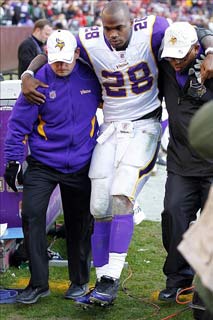Historical Running Back Injury Analysis
 It is a commonly held belief that running backs are very prone to injuries because of the position that they play. Like many common beliefs, the majority of people just take it at face value and assume it is true. This leads to all kinds of tactics to offset this notion, such as the handcuffing of running backs.
It is a commonly held belief that running backs are very prone to injuries because of the position that they play. Like many common beliefs, the majority of people just take it at face value and assume it is true. This leads to all kinds of tactics to offset this notion, such as the handcuffing of running backs.
We decided to take a little closer look at the injury rate for running backs to see if they really are injury prone as a position or if it is more a case of a few of them giving the whole group a bit of a bad name. The examination of this involved taking a look at the careers of no less than 43 different running backs.
In order to qualify for this study, the running back needed to be a top twenty scorer in a standard scoring PPR league at some point over the last six years. They also needed to have more than two seasons as a starter or as a part of a 1A/1B situation like DeAngelo Williams and Jonathan Stewart. Any running back who just earned a starting role or that were high performing rookies last year (like DeMarco Murray), are not a part of this study due to a limited sample size they would provide.
Here is a look at the big picture before we break it down a bit:
- They played a total of 3,925 games over the course of 277 seasons – an average of 14.17 games per season.
- In 126 of those seasons (45.5%) the running back played the entire 16 games.
- In 50 of those seasons (18.1%) the running back played 15 games.
- In 30 of those seasons (10.8%) the running back played 14 games.
- In 24 of those seasons (8.7%) the running back played 13 games.
- In 15 of those seasons (5.4%) the running back played 12 games
- In 32 of those seasons (11.6%) the running back played 11 games or less.
The major numbers here are the 14.17 games per season average, the 45.5% of seasons where the back played all 16 games, and the 11.6% of seasons with 11 games or less signifying a major injury or several little injuries.
The 14.17 average would lead us to believe that we will need a replacement for our running backs roughly two games a year. When you add in bye weeks, you are looking at six weeks where your RB3 is going to be in the starting lineup in place of either your RB1 or RB2 over the course of a normal season.
Purely looking at the averages can be a little bit misleading as almost half of the time the backs played the entire season without missing a game. Even that is a little bit low as a large portion of the 15 game seasons were the result of a playoff team resting their starting running back during week 17 of the season, so let’s add in the 15 game seasons to the 16 game seasons, which gives us healthy running backs in 63.5% of the seasons. If we use this 15+ game benchmark as our cutoff for a healthy season, a few other trends start to develop.
- 6 of the 43 running backs were healthy in at least 90% of their seasons
- 17 of the 43 running backs were healthy in at least 75% of their seasons
- 35 of the 43 running backs were healthy in at least 50% of their seasons
These numbers show that it is extremely rare for a running back to go a whole career without an injury. That is to be expected since this is the world of pro football. However, the fact that roughly 40% of the running backs are healthy in the vast majority of their seasons and that number jumping to 81% if we are just talking simple majority might call into question the convention that all running backs get hurt every year.
If we take a look at the other end of the spectrum, it paints an even clearer picture of what is really going on.
- 19 of the 43 running backs never had a season where they played 11 games or fewer
- 7 of the 43 running backs had more than 25% of their seasons where they played 11 games or fewer – this is part of our injury prone group as they have several major injuries over a career or tend to have multiple nagging injuries over a season. This includes high profile guys like Darren McFadden, Ronnie Brown, Fred Taylor, Cadillac Williams, and Reggie Bush.
- 4 of the 43 running backs had 50% of their seasons where they played in 13 games or less. This groups adds in players like Cedric Benson and DeAngelo Williams.
- Only 1 running back out of the 43 played in 13 or fewer games in more than 50% of their seasons. In fact, he has played in 13 or fewer games in 100% of his seasons. That is of course McFadden. For the record, he also had the lowest games per season average at 11.25 – the next closest was Jamaal Charles at 12.25 due to him missing most of last season with the ACL injury.
These numbers point out that it is, in fact, a small group of running backs who have a disproportionate number of games that are missed. If we ignore this bottom group, our average number of games played per season jumps up to 14.9, meaning we are expecting to use our top backup only a total of four games per season; twice for the bye week assuming they line up right, once for your RB1, and once for your RB2 .
What does this mean for the big picture?
The frequency of running back injuries seems to be a little bit overblown when speaking generally. Some running backs definitely are injured quite a bit, but the majority of them make it through the season with little or no health issues. This means that planning for that injury could actually be a bit of a waste.
That brings us to the idea of handcuffing.
If you trust the numbers, handcuffing might not be the best idea. The exceptions would be if you have one of the injury prone backs or you think that the “handcuff” you are rostering has a future as a starting running back. Otherwise, use that roster spot on someone that might be a starter someday because chances are the current starting running back is going to make it through the season.
- Final 2021 Pre-Draft Rookie Mock: Round Three - April 28, 2021
- Final 2021 Pre-Draft Rookie Mock: Round Two - April 26, 2021
- Final 2021 Pre-Draft Rookie Mock: Round One - April 25, 2021


































































